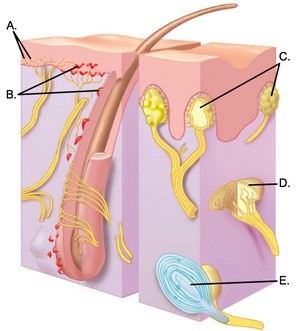 The diagram illustrates sensory receptors in the skin. What structure does "C" represent?
The diagram illustrates sensory receptors in the skin. What structure does "C" represent?
A. Free nerve endings
B. Meissner corpuscles
C. Merkel disks
D. Pacinian corpuscle
E. Ruffini end organ
Answer: B
You might also like to view...
Blood moves into and then out of a heart chamber because
A. it moves along its pressure gradient, and that gradient depends on contraction and relaxation during the cardiac cycle. B. it is under constant pressure, but its movement is dictated by the control of valve openings and closures. C. the veins and arteries constrict and dilate to propel and attract blood. D. All of the choices are correct.
The name of the mechanism in which pain sensations from visceral organs are often perceived as originating in more superficial regions is ________.
Fill in the blank(s) with the appropriate word(s).
If all other conditions remain the same and the concentration of a nonpenetrating solute increases inside a cell, which is most likely to occur?
A. Water will tend to enter the cell because the interior has an increased osmolarity. B. Water will tend to leave the cell because the interior has an increased osmolarity. C. Water will tend to enter the cell because the interior has a decreased osmolarity. D. Water will tend to leave the cell because the interior has a decreased osmolarity. E. The solute will diffuse across the membrane until its concentration is equal on both sides of the membrane.
Which of the following statements about the response of arteriolar smooth muscle to changing oxygen partial pressures is TRUE?
A. Both systemic and pulmonary arterioles respond to a decrease in PO2 by constricting. B. Both systemic and pulmonary arterioles respond to a decrease in PO2 by dilating. C. Systemic arterioles respond to a decrease in PO2 by dilating, but pulmonary arterioles constrict in response to decreased PO2. D. Systemic arterioles respond to a decrease in PO2 by constricting, but pulmonary arterioles dilate in response to decreased PO2. E. Changes in PO2 do not affect arteriolar smooth muscle in the pulmonary system.